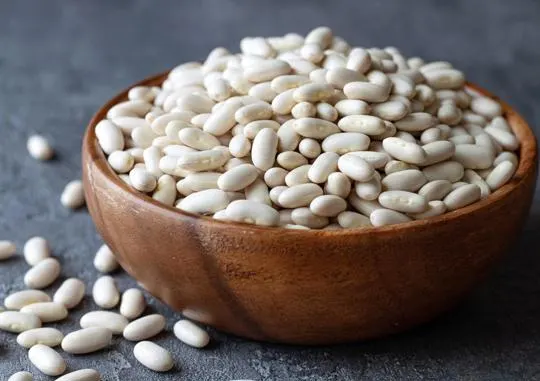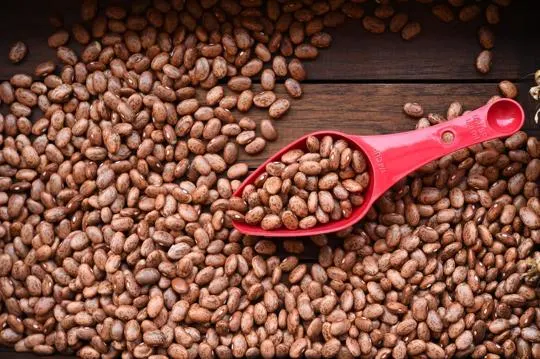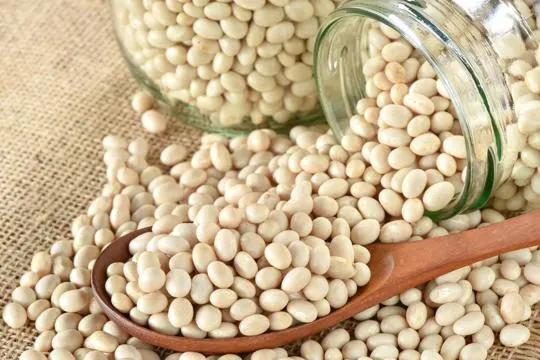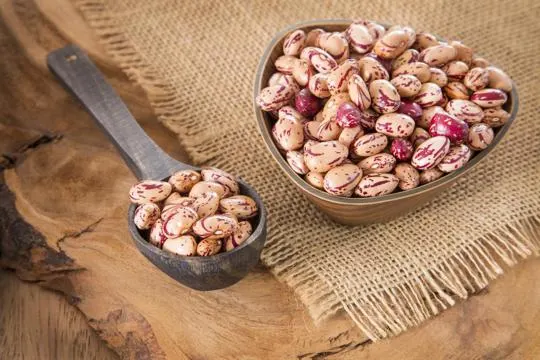Summary of key points
The main difference between navy beans and pinto beans is in their size, taste, and texture. Navy beans, also known as haricot beans, are small white beans that have a creamy texture and a mild flavor. Pinto beans are larger and have a beige color with mottled patterns on their skin.
In terms of taste, pinto beans have a richer and earthier flavor compared to navy beans. They also have a slightly firmer texture, making them popular in dishes such as refried beans or chili.
Nutritionally, both types of beans are high in fiber and protein, but pinto beans contain slightly more calories and carbohydrates per serving. Additionally, navy beans may be easier to digest for some individuals due to their smaller size.
Navy beans and pinto beans might look like distant cousins at the family BBQ, and honestly, we often mix them up.
Navy beans, small and mighty, pack a serious nutritional punch. Their size is deceiving. Then we’ve got the pinto beans, with their earthy flavor and smooth texture, stealing the spotlight in many of our favorite dishes.
Ever tried swapping them in your recipes? We did. The results were… interesting.
Navy beans bring a subtle flavor, blending in like they were always meant to be there. Pintos, on the other hand, shout from the rooftops, demanding attention.
It’s a showdown worth watching. And we’re here to break it down for you.
What are Navy Beans?

Navy beans, also known as haricot beans, are small white ones with a mild, creamy taste.
They got their name from being a staple food for the US Navy in the early 20th century.
These legumes are full of fiber, protein, and lots of nutrients.
They can be used in soups, stews, and baked dishes.
Navy beans absorb flavors really well. Season them with herbs and spices for different cuisines.
Plus, they’re great for making classic dishes like Boston baked beans and navy bean soup.
Navy beans offer many health benefits. They have dietary fiber, which helps digestion and blood sugar levels.
Plus, they’re high in folate, iron, magnesium, and potassium.
Also, they contain plant compounds like antioxidants.
These help guard against heart disease and some cancers.
Their low glycemic index makes them perfect for people with diabetes or those managing their blood sugar levels.
In conclusion, navy beans are small, white legumes that have been enjoyed for centuries.
They can be used in soups or as a side dish.
But most importantly, these healthy beans taste delicious.
What are Pinto Beans?

Pinto beans are famed for their speckled look and earthy taste.
They boast a creamy texture and a mild flavor.
Plus, these nutritious legumes are loaded with fiber, protein, and vital minerals.
They’re frequently cooked up in dishes like refried beans, chili, and bean salads.
Moreover, pinto beans are a flexible ingredient that can be added to multiple recipes, giving them more depth and substance.
Differences Between Navy Beans and Pinto Beans

Navy beans and pinto beans may seem alike, but they have differences.
Both are part of the legume family and filled with nutrients.
Navy beans, also known as haricot beans or white pea beans, are small and oval-shaped.
They have a mild flavor and creamy texture when cooked.
People often use them in dishes such as baked beans, soups, and stews because they absorb other flavors well.
In addition, navy beans are high in fiber and contain lots of folate, magnesium, and iron.
Pinto beans, named after the Spanish word for “painted,” have a beige background with brown speckles.
They are medium-sized and hold their shape when cooked.
This makes them great for Mexican dishes such as refried beans, chili con carne, and burritos.
They also have a nutty flavor and provide protein, dietary fiber, potassium, and manganese.
The final difference between navy and pinto beans is cooking time.
Navy beans are smaller, so they cook faster.
It’s suggested to soak them for 1-2 hours, whereas pinto beans need 2-4 hours.
Appearance and Size
Navy beans are like small, white pearls – while pinto beans are bigger and have cream and brown speckles.
Navy beans are about 1/2 inch long, but pinto beans are around 1 inch.
Navy beans have a delicate flavor, and they’re great for soups and stews.
Pinto beans have an earthy taste and creamy texture – perfect for Mexican dishes like refried beans or chili.
This makes them really different.
Flavor and Taste
Navy beans and pinto beans are two different legumes with distinct tastes and textures.
Navy beans have a mild, slightly nutty flavor and creamy texture when cooked.
Pinto beans, however, have a richer and earthier taste, plus a hint of smokiness, and hold their shape better.
The cooking method for each type of bean can change its flavor.
Slow-cooking navy beans with herbs and spices can enhance their flavor.
Simmering pinto beans with bacon or ham hocks can add smokiness.
Both navy and pinto beans provide protein, fiber, and essential nutrients.
They can be used in many dishes, allowing you to create unique culinary creations that suit any palate.
Nutritional Content
Navy beans and pinto beans may look similar, but their nutritional content is different.
Both offer unique benefits for your health.
Navy beans are a great source of protein and fiber.
Plus, they have all the amino acids the body needs to build and repair tissues.
Folate, which is important for pregnant women, is also in navy beans.
Pinto beans have iron and manganese.
Iron helps move oxygen around the body and manganese supports bone health and blood sugar regulation.
Antioxidants, which protect cells from damage, are found in pinto beans too.
Both navy and pinto beans are low in fat and cholesterol-free.
Complex carbs give you sustained energy and help keep your blood sugar steady.
Plus, they contain potassium, magnesium, and phosphorus, which help with heart health and muscle function.
So, navy beans offer protein, fiber, and folate. Pinto beans have iron, manganese, and antioxidants.
These legumes can both contribute to a healthy diet.
Cooking Time and Texture
Cooking navy and pinto beans differ in time and texture.
Navy beans take around 45 to 60 minutes of cooking, resulting in a soft and creamy texture.
Perfect for soups, stews, and baked dishes.
Pinto beans, however, require 1.5 to 2 hours of cooking.
They have a slightly grainy texture with a nutty flavor; ideal for Mexican recipes like refried beans or burrito fillings.
In terms of texture, navy beans are smoother than pinto beans.
They easily absorb flavors from other ingredients, making them a great choice for seasoning and spices.
Both types of beans are versatile. So, choose according to your cooking and texture preferences.
Enjoy the yummy possibilities of these legumes.
Similarities Between Navy Beans and Pinto Beans

Navy beans and pinto beans have something in common.
They are both from the legume family.
This means they are both good sources of plant-based protein.
Plus, they are high in fiber, vitamins, and minerals.
You can use them both in the same recipes like soups, stews, and chili.
So, if you want to get some healthy nutrition, go with either navy or pinto beans.
Culinary Uses of Navy Beans and Pinto Beans
Navy beans and pinto beans are great for cooking.
These legumes have different flavors, textures, and nutritional benefits.
They can be used in soups, stews, and chili recipes.
Navy beans often work well in baked bean recipes.
Pinto beans have an earthy taste that goes with Mexican and Southwestern dishes.
Navy beans can be turned into a puree to make dips or spreads.
Pinto beans can be mashed for refried beans or as a filling for tacos and burritos.
They provide an alternative to meat in vegetarian or vegan recipes, too.
Navy beans can also be ground into a flour for gluten-free baking.
These two types of beans offer many possibilities for cooking.
Get creative and explore the endless options that navy beans and pinto beans can provide.
Health Benefits and Nutritional Value Comparison
Navy beans and pinto beans are often compared. They have distinctive characteristics.
Navy beans have less calories than pinto beans.
Plus, they are a good source of fiber, protein and iron.
Pinto beans provide more potassium and magnesium.
Both types of beans offer antioxidants.
So, either way, these nutritious legumes can benefit your health.
Which Bean is Best for Specific Dishes?
Choosing a bean for a dish is hard.
Navy beans and pinto beans have their own qualities.
Navy beans are small, oval, smooth, and mild-tasting.
They hold their shape when cooked long and absorb flavors easily.
So, they’re perfect for dishes with spices and seasonings.
Pinto beans are larger with a mottled color.
They have a creamy texture and an earthy taste.
They are used in Mexican cuisine like refried beans or chili con carne.
They can handle bold spices like cumin and chili powder.
Texture and flavor are important when selecting a bean.
Navy beans are good for hearty consistency and subtle flavors.
Pinto beans work well for a creamier texture with an earthy undertone.
Nutrition-wise, navy beans have high fiber content and essential nutrients.
Pinto beans have similar benefits, but more calories.
So, try both navy and pinto beans and see what you prefer.
Let your creativity soar in the kitchen.
Conclusion
Ultimately, navy beans and pinto beans are both delicious, versatile additions to your kitchen pantry.
Both offer substantial amounts of dietary fiber, protein, and many essential vitamins and minerals.
While subtle differences do exist between the two legumes in taste and texture, they can often be used interchangeably in recipes without sacrifice of flavor or outcome.
Navy beans are perhaps more appropriate for broths where the color is a concern, while pinto beans may fare better with other bolder flavors that help them blend in nicely.
With their combination of nutrition and deliciousness, it’s no wonder why these two types of beans form such a staple part of American cuisines.
Whether you favor one bean over the other or use them both together, you won’t regret adding navy beans and/or pinto beans to your breakfasts, lunches and dinners.
Their great taste promises to become a favorite addition no matter which recipes you choose.

Leave a comment